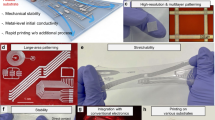Abstract
Conventional 3D metal printings are generally time-consuming as well as lacking of high performance printable inks. From an alternative way, here we proposed the method of liquid phase 3D printing for quickly making conductive metal objects. Through introducing metal alloys whose melting point is slightly above room temperature as printing inks, several representative structures spanning from one, two and three dimension to more complex patterns were demonstrated to be quickly fabricated. Compared with the air-cooling in a conventional 3D printing, the liquid-phase-manufacturing offers a much higher cooling rate and thus significantly improves the speed in fabricating the target metal objects. This unique strategy also efficiently prevents the liquid metal inks from air oxidation, which is hard to avoid otherwise in an ordinary 3D printing. The key physical factors (such as properties of the cooling fluid, air pressure within the syringe barrel and needle diameter, types and properties of the printing ink) and several interesting intermediate fluids interaction phenomena between liquid metal and conventional cooling fluids such as water or ethanol, which evidently affecting the printing quality, were disclosed. In addition, a basic route to make future liquid phase 3D printer incorporated with both syringe pump and needle arrays was also suggested. The liquid phase 3D printing, which owns potential values not available in a conventional method, opens an efficient way for quickly making conductive metal objects in the coming time.
Similar content being viewed by others
References
Symes M D, Kitson P J, Yan J, et al. Integrated 3D-printed reactionware for chemical synthesis and analysis. Nat Chem, 2012, 4: 349–354
Therriault D, White S R, Lewis J A. Chaotic mixing in three-dimensional microvascular networks fabricated by direct-write assembly. Nat Mater, 2003, 2: 265–271
Griffith L G, Naughton G. Tissue engineering — Current challenges and expanding opportunities. Science, 2002, 295: 1009
Seyednejad H, Gawlitta D, Dhert W J A, et al. Preparation and characterization of a three-dimensional printed scaffold based on a functionalized polyester for bone tissue engineering applications. Acta Biomater, 2011, 7: 1999–2006
Bergmann C, Lindner M, Zhang W, et al. 3D printing of bone substitute implants using calcium phosphate and bioactive glasses. J Eur Ceram Soc, 2010, 30: 2563–2567
Kim M S, Chu W S, Kim Y M, et al. Direct metal printing of 3D electrical circuit using rapid prototyping. Int J Precis Eng Man, 2009, 10: 147–150
Lopes A J, MacDonald E, Wicker R B. Integrating stereolithography and direct print technologies for 3D structural electronics fabrication. Rapid Prototyping J, 2012, 18: 129–143
Gu D D, Meiners W, Wissenbach K, et al. Laser additive manufacturing of metallic components: Materials, processes and mechanisms. Int Mater Rev, 2012, 57: 133–164
Asgharzadeh H, Simchi A. Effect of sintering atmosphere and carbon content on the densification and microstructure of laser-sintered M2 high-speed steel powder. Mat Sci Eng A-Struct, 2005, 403: 290–298
Santos E C, Shiomi M, Osakada K, et al. Rapid manufacturing of metal components by laser forming. Int J Mach Tool Manu, 2006, 46: 1459–1468
Kruth J P, Wang X, Laoui T, et al. Lasers and materials in selective laser sintering. Assembly Autom, 2003, 23: 357–371
Liu J, Zhou Y X. A computer chip cooling device using liquid metal with low melting point and its alloys as the cooling fluid. China Patent, 2002, No. 021314195
Gao Y X, Liu J. Gallium-based thermal interface material with high compliance and wettability. Appl Phys A: Mater S, 2012, 107: 701–708
Mei S F, Gao Y X, Li H Y, et al. Thermally induced porous structures in printed gallium coating to make transparent conductive film. Appl Phys Lett, 2013, 102: 041905
Zhang Q, Zheng Y, Liu J. Direct writing of electronics based on alloy and metal ink (DREAM ink): A newly emerging area and its impact on energy, environment and health sciences. Front Energy, 2012, 6: 311–340
Gao Y X, Li H Y, Liu J. Direct writing of flexible electronics through room temperature liquid metal ink. PLoS One, 2012, 7: e45485
Gao M, Gui L, Liu J. Study of liquid-metal based heating method for temperature gradient focusing purpose. ASME J Heat Transfer, 2013, 135: 091402
Zheng Y, He Z, Gao Y, et al. Direct desktop printed-circuits-on-paper flexible electronics. Sci Rep, 2013, 3: 1786
Jin C, Zhang J, Li X K, et al. Injectable 3-D fabrication of medical electronics at the target biological tissues. Sci Rep, 2013, 3: 3442
Yu Y, Wang Q, Liu J. Channelless fabrication for large-scale preparation of room temperature liquid metal droplets. Adv Eng Mater, 2014, 16: 255–262
Cramer C, Fischer P, Windhab E J. Drop formation in a co-flowing ambient fluid. Chem Eng Sci, 2004, 59: 3045–3058
Richards J, Baris A, Lenhoff A. Drop formation in liquid-liquid systems before and after jetting. Phys Fluids, 1995, 7: 2617–2630
Cramer C, Studer S, Windhab E J, et al. Periodic dripping dynamics in a co-flowing liquid-liquid system. Phys Fluids, 2012, 24: 093101
Dong H M, Carr W W, Morris J F. An experimental study of drop-on-demand drop formation. Phys Fluids, 2006, 18: 072102
Xu Q, Basaran O A. Computational analysis of drop-on-demand drop formation. Phys Fluids, 2007, 19: 102111
Author information
Authors and Affiliations
Corresponding author
Rights and permissions
About this article
Cite this article
Wang, L., Liu, J. Liquid phase 3D printing for quickly manufacturing conductive metal objects with low melting point alloy ink. Sci. China Technol. Sci. 57, 1721–1728 (2014). https://doi.org/10.1007/s11431-014-5583-4
Received:
Accepted:
Published:
Issue Date:
DOI: https://doi.org/10.1007/s11431-014-5583-4




